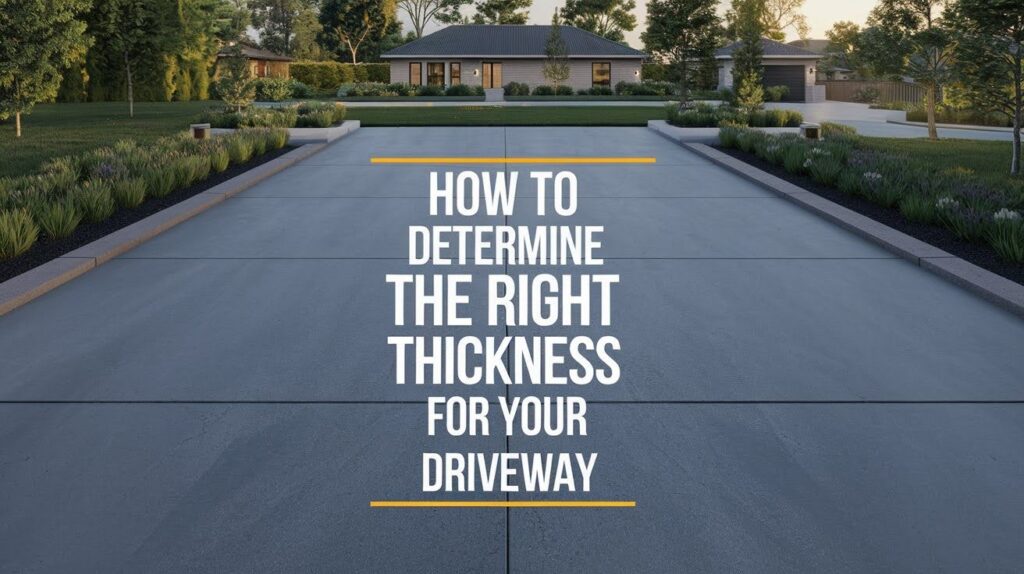After twenty years of installing driveways across suburban neighborhoods, I’ve seen countless homeowners make the same costly mistake: skimping on thickness.
Last month alone, I received three calls from frustrated property owners whose thin driveways had cracked beyond repair within just two years.
The truth is, proper driveway thickness isn’t just about following building codes – it’s about protecting your investment and avoiding expensive repairs down the road.
Residential driveways typically require different specifications than commercial properties due to varying load requirements and traffic patterns.
Getting this fundamental aspect right from the start means the difference between a driveway that lasts decades versus one that becomes a maintenance headache. Let me share what I’ve learned about making this critical decision correctly.
Factors That Affect Driveway Thickness

Soil Type and Base Preparation
Not all soil supports concrete equally. Clay soil expands and contracts with moisture, creating pressure that cracks concrete. Sandy, well-draining soil provides much better stability.
Your subbase matters more than most homeowners realize. I always recommend 4-6 inches of compacted gravel or crushed stone beneath the concrete. This distributes weight evenly and prevents settling that leads to cracks.
Good drainage prevents water from pooling under your driveway. When water freezes, it expands and creates expensive damage.
Vehicle Weight and Intended Use
Your Honda Civic needs different support than a heavy pickup truck or RV. Standard passenger vehicles work fine with minimum thickness, but heavier vehicles require thicker concrete.
The relationship is simple: double the thickness, handles roughly four times the weight. Plan for your heaviest regular use, not just daily driving.
Local Building Codes and HOA Rules
The International Residential Code requires 3.5-4 inches minimum, but local codes often demand more. Frost lines, soil conditions, and municipal requirements can push this to 6 inches or higher.
Check your HOA rules too. Many require thicker concrete at street connections or specific edge treatments that affect your planning.
Recommended Concrete Driveway Thickness
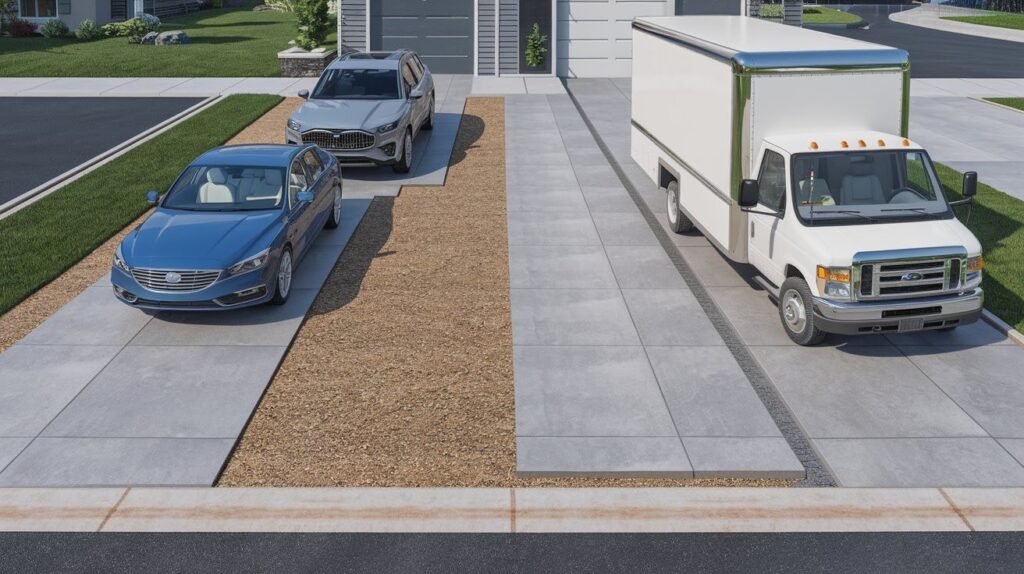
Residential Driveways
For most homeowners with standard cars and SUVs, 4 inches of concrete provides adequate support. This meets building codes and handles typical family vehicle weights without issues.
However, I recommend 5-6 inches if you regularly park heavier vehicles like large pickup trucks, work vans, or RVs. The extra inch or two adds significant strength and extends your driveway’s lifespan considerably.
Yes, it costs more upfront, but replacing a failed driveway costs far more than doing it right initially.
Commercial or Heavy-Duty Driveways
Commercial properties face different demands entirely. Delivery trucks, service vehicles, and constant traffic require 6-8 inches of concrete thickness minimum. I’ve seen 4-inch commercial driveways fail within months due to inadequate planning.
The subbase becomes even more critical here. Commercial projects need at least 6 inches of compacted gravel base, sometimes more depending on soil conditions and expected loads. This isn’t an area to cut corners, business operations depend on reliable access.
Edge Thickness Considerations
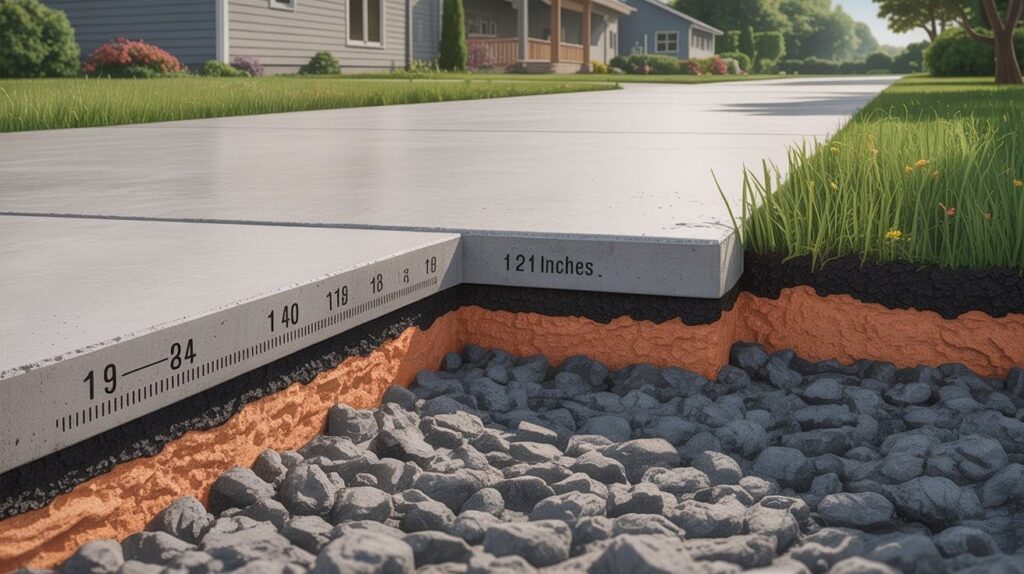
Driveway edges are the most vulnerable spots because they lack support on one side. I’ve seen countless driveways where cracks start at the edges and spread inward.
The fix is simple: increase edge thickness by 1-2 inches beyond your main slab. If your driveway is 4 inches thick, make the edges 5-6 inches thick.
Don’t stop there-extend this thicker section 12-18 inches inward from each edge. This prevents stress points where different thicknesses meet and creates a stronger perimeter that protects your entire driveway.
This small upgrade costs slightly more in concrete but prevents the most common failure pattern in residential driveways.
Concrete Strength (PSI Ratings)
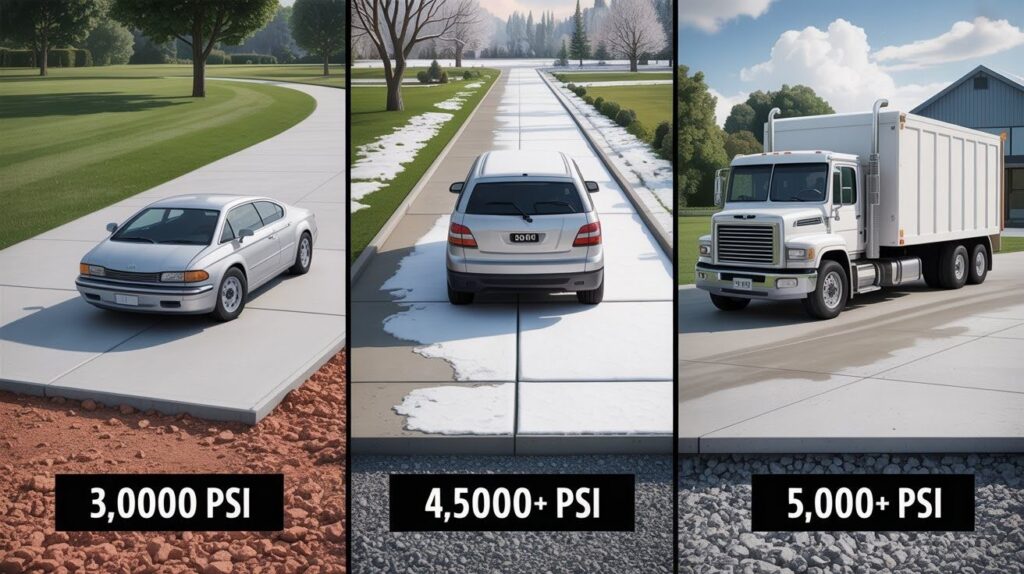
PSI ratings tell you how much pressure your concrete can handle per square inch. For typical residential driveways, 3,000-4,000 PSI concrete works perfectly fine. This strength handles standard family vehicles and normal weather conditions without problems.
If you live where winters bring freeze-thaw cycles, bump up to 4,500+ PSI. I’ve learned this lesson from too many cracked driveways in northern climates. The stronger concrete resists damage when water freezes and expands in tiny cracks.
Commercial properties or homeowners with heavy vehicles need 5,000+ PSI concrete. This higher strength costs more but handles delivery trucks, RVs, and constant traffic loads that would stress weaker concrete.
Don’t let contractors talk you into the cheapest option if your situation requires stronger concrete. Saving $200 on concrete strength can cost thousands in premature replacement.
Reinforcement Options
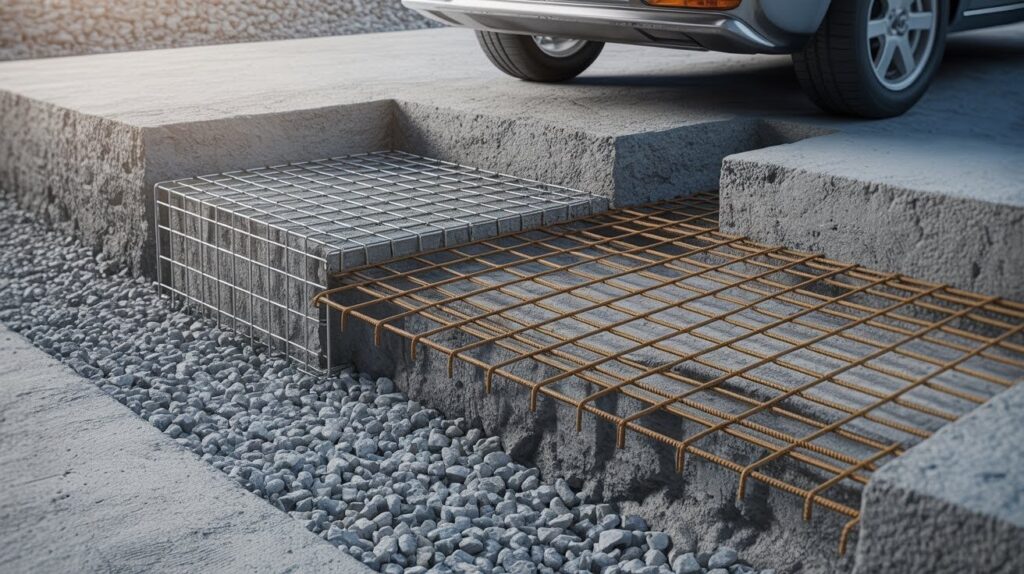
Wire Mesh
Wire mesh works well for most residential driveways, especially 4-5 inch slabs in areas with stable soil and moderate weather.
It’s cost-effective and helps prevent cracks from spreading across your entire driveway. I use wire mesh for standard installations where homeowners park typical family vehicles.
Rebar
When your driveway is 5 inches thick or more, rebar becomes necessary. I also recommend it for heavy vehicle loads or problematic soil conditions like clay that shifts with moisture. Rebar creates a stronger internal skeleton that handles stress better than wire mesh alone.
The spacing matters – I typically place rebar every 18-24 inches in both directions, positioned in the lower third of your concrete slab for maximum effectiveness.
Fiber Mesh
Fiber mesh gets mixed directly into your concrete and helps control small surface cracks. While it’s a nice addition, don’t let anyone convince you it replaces proper rebar or wire mesh.
Think of fiber mesh as extra insurance, not your primary reinforcement strategy.For heavy-duty applications, I often combine fiber mesh with rebar for maximum crack resistance.
Expansion Joints and Crack Prevention
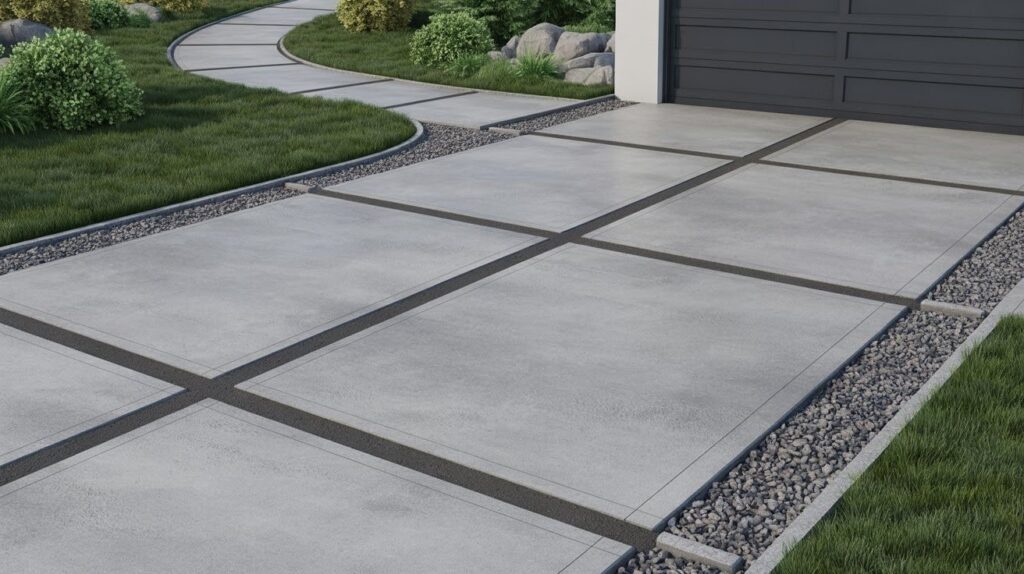
Concrete moves – it expands in heat and contracts in cold. Without proper expansion joints, your driveway will crack wherever it wants to, creating ugly random lines across your surface.
I space expansion joints every 8-12 feet for 4-inch slabs. Thicker slabs can handle slightly wider spacing, but don’t push it beyond 15 feet. These controlled joints give concrete a designated place to crack, keeping it neat and manageable.
Smart placement matters too. Line up your joints with natural transitions like where your driveway meets the garage or changes direction. This creates clean sight lines and prevents awkward joint placement that looks amateur.
Proper joint placement extends your driveway’s life significantly. Instead of random cracks appearing after a few years, you get controlled movement that’s easy to seal and maintain. The small upfront cost of cutting these joints saves major repair expenses later.
Cost vs. Performance
Adding thickness increases concrete costs roughly 25% per additional inch, but the benefits aren’t always proportional. Going from 4 to 5 inches costs about $1.50 more per square foot while significantly improving durability.
However, investing in proper base preparation often provides better returns than extra concrete thickness. A 4-inch slab on excellent base prep typically outperforms a 6-inch slab on poor ground.
Quality base prep costs around $2 per square foot, while increasing thickness from 4 to 6 inches adds $3-4 per square foot. You get better performance for less money by focusing on what’s underneath your concrete.
Smart contractors know this-if someone pushes extra thickness without discussing base prep, find someone else.
Sealing and Maintenance Tips
- Seal your driveway every 2-3 years to protect against water damage, oil stains, and freeze-thaw cycles. This simple step can double your driveway’s lifespan at minimal cost compared to replacement.
- Add non-slip additives to your sealer for safety, especially on sloped driveways. These maintain traction in wet conditions without affecting the sealer’s protective qualities.
- Inspect your driveway twice yearly for small cracks, settling spots, or drainage issues. Catching problems early means $50 repairs instead of $500 problems later.
Conclusion
After two decades of pouring driveways, I’ve seen the results of both smart decisions and costly shortcuts. For most homeowners, 4-inch concrete works fine for standard vehicles, but 5-6 inches provides better long-term value for heavier use.
Commercial properties need 6-8 inches minimum-no exceptions.
Remember, your driveway thickness decision isn’t just about meeting minimum codes. It’s about balancing your budget with realistic load requirements and how long you want this investment to last.
A properly designed driveway with adequate thickness, quality base preparation, and regular maintenance will serve your property for decades.
Don’t let contractors talk you into unnecessary upgrades, but don’t skimp on the fundamentals either. Get the thickness right from the start, and you’ll thank yourself years later.
Frequently Asked Questions
What’s the minimum thickness for a residential driveway?
Most building codes require 4 inches for residential driveways with standard vehicle use. This thickness adequately supports typical family cars and light trucks under normal conditions.
Do I need thicker concrete for my RV or heavy truck?
Yes, vehicles over 8,000 pounds require 5-6 inches of concrete thickness for proper support. The extra thickness prevents cracking and extends your driveway’s lifespan significantly.
How much does increasing the thickness from 4 to 5 inches cost?
Adding one inch of thickness typically increases costs by $1.50-2.00 per square foot. While this seems expensive, it’s much cheaper than replacing a failed thin driveway later.
Should I use rebar or wire mesh for reinforcement?
Wire mesh works for 4-inch residential slabs in good soil conditions. Rebar becomes necessary for 5+ inch slabs, heavy vehicles, or poor soil that shifts with moisture.
How important is the gravel base compared to the concrete thickness?
Proper base preparation often matters more than extra concrete thickness. A 4-inch slab on well-compacted gravel typically outperforms thicker concrete on poorly prepared ground.

